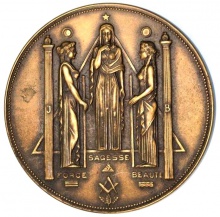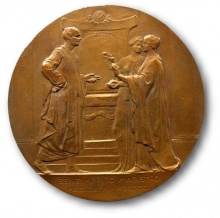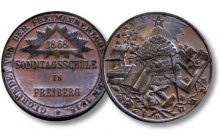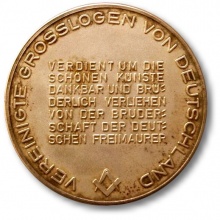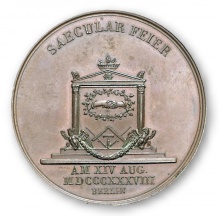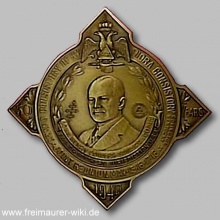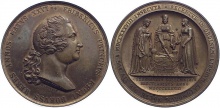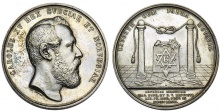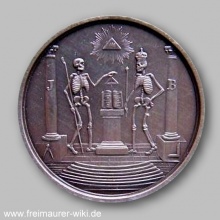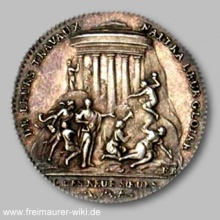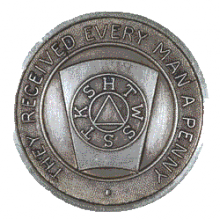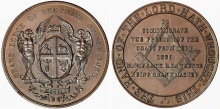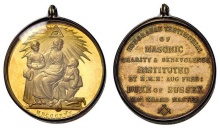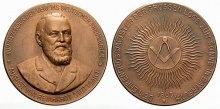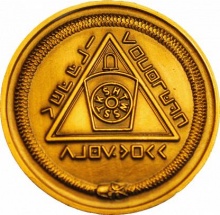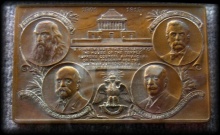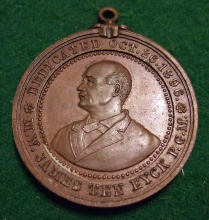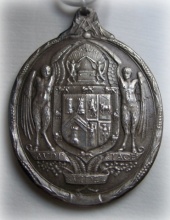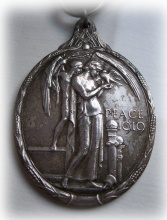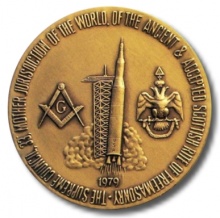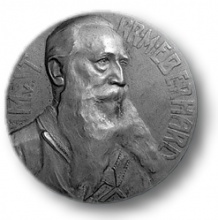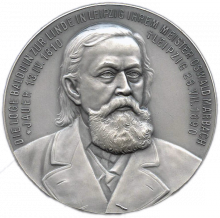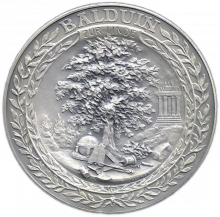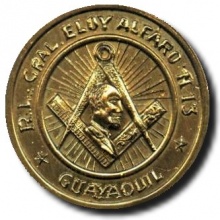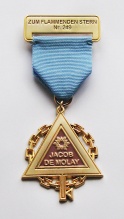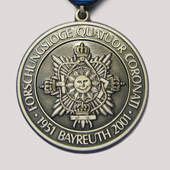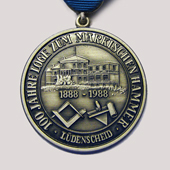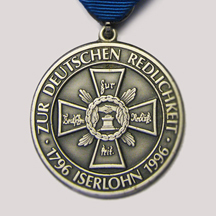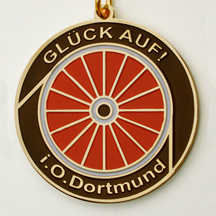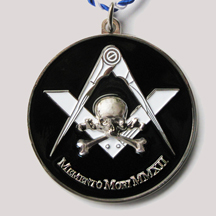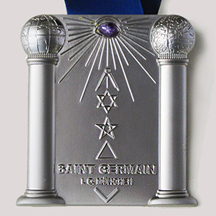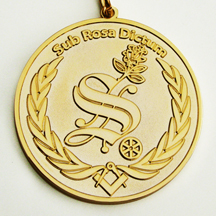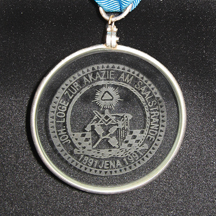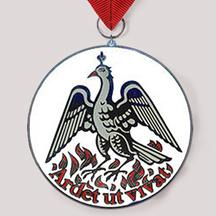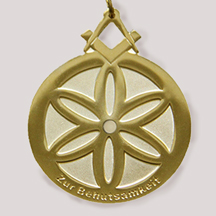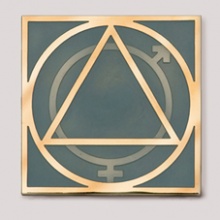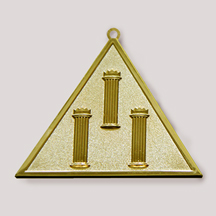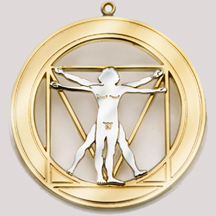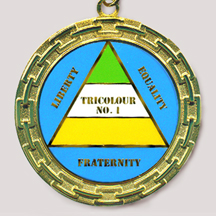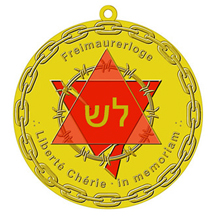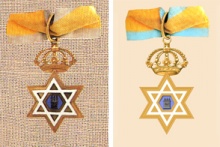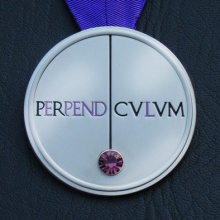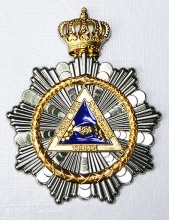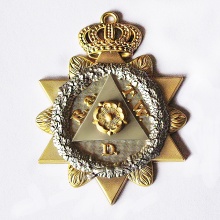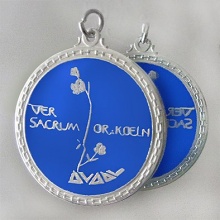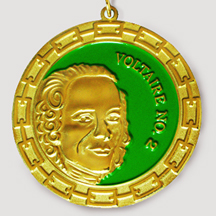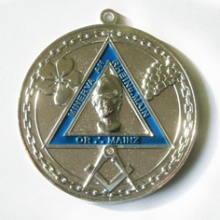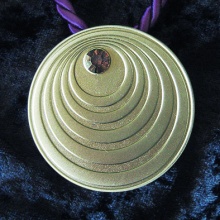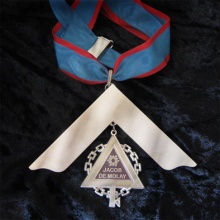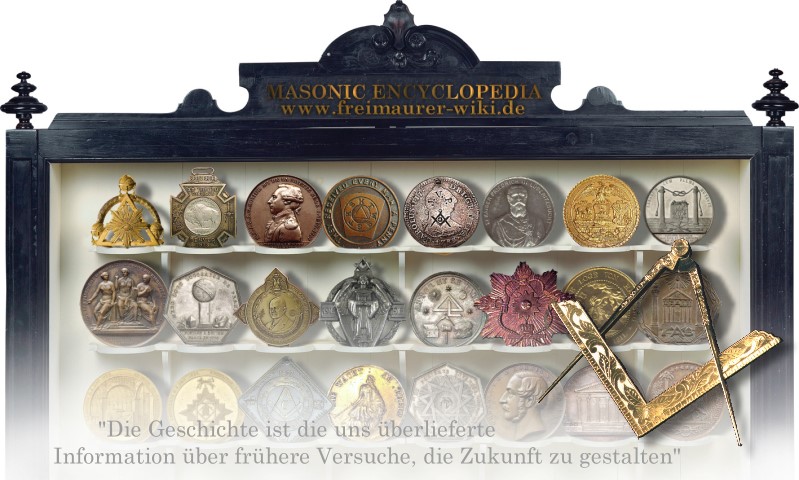
Bijoux und Medaillen

Image Courtesy of Brother Chris John Beckett: Knight Templar Masonic medals and insignia. In an exhibition case at Dartford Masonic Centre, West Hill, Dartford, Kent.

Image Courtesy of Brother Chris John Beckett: The Cross of Constantine, Holy Arch, and other Masonic medals and insignia. In an exhibition case at Dartford Masonic Centre, West Hill,Dartford, Kent.
Logen Bijoux
Plural: Bijoux, franz. für 'Kleinod'
Ein Bijou ist das Logenabzeichen der Freimaurer. Es ist in vielen aber nicht in allen Logen üblich.
Darüberhinaus gibt es zu besonderen Anlässen und Ehrungen Gedenkmedaillen und Münzen mit freimaurerischen Motiven.
Das umfassendste Kompendium wurde zusammengestellt von Br. Ernst-Günther Geppert.
Münzen und Medaillen
Medaille 1901 Wien Bronze Max Neuda gewidmed von der Loge "Zukunft"
Rückseite der Widmungsmedaille für Max Neuda
Großlogen von Deutschland
Masoneria Universale / Italien
Säcularfeier Aufn. Friedrichs II.
Karl XV von Schweden und Norwegen. Großmeister-Medaille 1872.
Charity-Medaille Duke of Sussex 1926
Masonic jewels made by French prisoners of war, 1790-1815
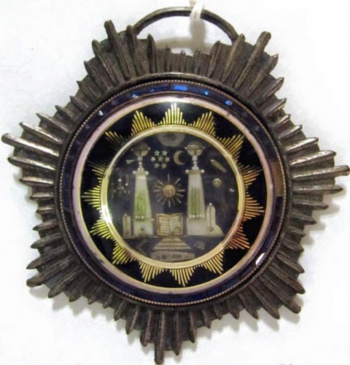 Jewel made by a French Prisoner of War in England during the Napoleonic Wars (1793-1815).
Jewel made by a French Prisoner of War in England during the Napoleonic Wars (1793-1815).
Jewels such as this will be available for viewing at the Exhibition held at Dore Masonic Hall Sheffield on the 9th-10th of July 2016.
Masonic jewels made by French prisoners of war, 1790-1815. During the Napoleonic Wars there were a large number of French Prisoners detained in England, amounting at one time as many as 140,000. Amongst the Prisoners was a good proportion who were Freemasons and their number can be judged from the fact that they were numerous enough to organise Lodges among themselves in various parts of England where they were detained.
As many as 30 Lodges formed by French Prisoners are on record. There was no Red Cross at this time and supplies were very limited so they worked to earn sufficient money with which to keep themselves. The more skilled amongst them were able to make the items exhibited here. They used whatever material were available, scraps of bone, mother-of-pearl and tinsel and for models they used the breast jewels worn by Freemasons worn at the time.
In the second half of the eighteenth and the early part of the nineteenth centuries, in the decades that Great Britain and France were at war, great numbers of French military personnel were captured and brought to Britain as prisoners. The greatest concentration of these was during the Revolutionary Wars of 1797-1814, when over 122,000 French prisoners resided in camps all across Britain, under conditions that were often, although not always, harsh.
Those prisoners that were freemasons could often expect kind treatment from British freemasons, being taken into their homes and lodges. The prisoners also founded lodges within their own camps. As a method of occupation and, often of money-making, these prisoners produced souvenir and novelty items from what materials they could find; figures and models from paper, bone, wood and straw. They also made masonic plaques from these basic materials. The items were then sold or traded at market and later set into metal and glass surrounds, ensuring their survival today.
Source: Sheffield Freemasonry
Galerie Hajo Naber
"Jacob DeMolay - ZUM FLAMMENDEN STERN Nr. 249", komplette Überarbeitung in Mattgold
Forschungsloge „Quatuor Coronati“, VGLvD, zum 50 Jubiläum.
Loge „Zum Märkischen Hammer“, Lüdenscheid, GLLFvD, 100 Jahre, Darstellung Logenhaus, Zirkel und Winkel, Kelle und Hammer
Loge „Zur deutschen Redlichkeit“, Iserlohn, AFuAM, 200 Jahre, Darstellung altes Bijou „Zur teutschen Redlichkeit“
Loge „Glück Auf!“ Nr. 6, i. O. Dortmund (SGOvD) – Lichteinbr. 2004
Loge „MEMENTO MORI MMXII“ Nr. 12, i. O. Kaiserslautern (SGOvD) – Arbeitsbeginn 2013
Loge „SAINT GERMAIN“, i. O. München, jetzt Augsburg (Humanitas) mattversilbert mit Naturamethyst.
Loge „Zur Rose an Severi“ Nr. 10, i. O. Eisenach (SGOvD) - Lichteinbr. 2014
Loge „Zur Akazie am Saalstrande“ zu Jena (GLLFvD) Bijou besteht aus Brillenglasfassung mit eingesetztem Glas, das Siegel wurde von der Rückseite Feingesandstrahlt.
Loge „PHOENIX Europäische Wanderloge“ Nr. 1, i. O. Düsseldorf (SGOvD)
Loge „Zur Behutsamkeit“ Nr. 9, i. O. Rosenheim (SGOvD)
Bijou des "Souveränen GrossOrient von Deutschland" (SGOvD).
Verein „Drei Weise“, nicht mehr existent.(keine Großloge)
Loge „Leonardo da Vinci“ i. O. Wien (Humanitas Deutschland)
Loge „Tricolour No. 1“, Killarny/Kerry (GOoIr) – diese Loge existiert nicht mehr.
Entwurf für eine Loge in Münster, zu deren Gründung es leider nie kam. Loge „Liberté Chérie – in Memoriam“ in Erinnerung an die gleichnamige Loge im KZ Aussenlager Esterwege.
Rekonstruktion eines nicht mehr existierenden Bijou, Loge Anklam 1935 geschlossen "Julius zu den drei empfindsamen Herzen“, GNM3WK, altes Foto und danach gemachte Rekonstruktion.
Beamtenabzeichen SGOvD zweilagig Gold immer das Unterteil, Silber immer das aufgelegte Element. Alles Einzelstücke.
Loge "PERPENDICULUM", Frauenloge in Münster (FGLD) Entwurf: Barbara Flenker, Ausführung und Beschaffung: Hajo Naber, Mattversilbert mit künstlichem Amethyst und Farbeinlage.
Bijou der Loge "Armin zur Treue" Bielefeld (AFuAM), nach alter Vorlage komplett neu erstellt, Silber/Gold glänzend.
Loge "Zur Rose am Theutoburger Walde" Detmold (AFuAM)nach alter Vorlage komplett neu erstellt, Gold/Silber/Gold mattglänzend, dreilagig.
Neues Bijou, der Loge "Ver Sacrum" i.O. Köln (AFuAM), beidseitig gleiches Motiv, Mattversilbert, blaue Farbeinlage, vor einem Spiegel fotografiert.
Loge „Voltaire“, Corg (GOoIr) 2010 Sogenannte Forschungsloge, diese Loge existiert nicht mehr.
Loge „Minerva an Rhein und Main“, Mainz GL HUMANITAS, komplette Neubearbeitung, Silber glänzend
Loge "Momentum", Frauenloge in Dresden (FGLD), Mattversilbert mit Kunst-Amethyst.
Loge "Minerva", Frauenloge in Weimar (FGLD), Mattversilbert mit echtem Amethyst(getrommelt)dadurch ist jedes Bijou ein Unikat.
"Jacob DeMolay - ZUM STERN im Westen Nr. 249C", neu geschaffenes Halsabzeichen für Altstuhlmeister. Rot gekantetes blaues Halsband, darunter ein glechschenkeliger matt versilberter ganz schlichter Winkel an dem, in der Art der engl. Altmeisterabzeichen, ein in diesem Fall mattversilbertes Original-Bijou angehängt ist.
Kontakt: Website Hajo Naber Hans-Joachim Naber
Werdohler Landstr. 297
58513 Lüdenscheid
Tel: 02351-921956
Galerie Hajo Naber
"Jacob DeMolay - ZUM FLAMMENDEN STERN Nr. 249", komplette Überarbeitung in Mattgold
Forschungsloge „Quatuor Coronati“, VGLvD, zum 50 Jubiläum.
Loge „Zum Märkischen Hammer“, Lüdenscheid, GLLFvD, 100 Jahre, Darstellung Logenhaus, Zirkel und Winkel, Kelle und Hammer
Loge „Zur deutschen Redlichkeit“, Iserlohn, AFuAM, 200 Jahre, Darstellung altes Bijou „Zur teutschen Redlichkeit“
Loge „Glück Auf!“ Nr. 6, i. O. Dortmund (SGOvD) – Lichteinbr. 2004
Loge „MEMENTO MORI MMXII“ Nr. 12, i. O. Kaiserslautern (SGOvD) – Arbeitsbeginn 2013
Loge „SAINT GERMAIN“, i. O. München, jetzt Augsburg (Humanitas) mattversilbert mit Naturamethyst.
Loge „Zur Rose an Severi“ Nr. 10, i. O. Eisenach (SGOvD) - Lichteinbr. 2014
Loge „Zur Akazie am Saalstrande“ zu Jena (GLLFvD) Bijou besteht aus Brillenglasfassung mit eingesetztem Glas, das Siegel wurde von der Rückseite Feingesandstrahlt.
Loge „PHOENIX Europäische Wanderloge“ Nr. 1, i. O. Düsseldorf (SGOvD)
Loge „Zur Behutsamkeit“ Nr. 9, i. O. Rosenheim (SGOvD)
Bijou des "Souveränen GrossOrient von Deutschland" (SGOvD).
Verein „Drei Weise“, nicht mehr existent.(keine Großloge)
Loge „Leonardo da Vinci“ i. O. Wien (Humanitas Deutschland)
Loge „Tricolour No. 1“, Killarny/Kerry (GOoIr) – diese Loge existiert nicht mehr.
Entwurf für eine Loge in Münster, zu deren Gründung es leider nie kam. Loge „Liberté Chérie – in Memoriam“ in Erinnerung an die gleichnamige Loge im KZ Aussenlager Esterwege.
Rekonstruktion eines nicht mehr existierenden Bijou, Loge Anklam 1935 geschlossen "Julius zu den drei empfindsamen Herzen“, GNM3WK, altes Foto und danach gemachte Rekonstruktion.
Beamtenabzeichen SGOvD zweilagig Gold immer das Unterteil, Silber immer das aufgelegte Element. Alles Einzelstücke.
Loge "PERPENDICULUM", Frauenloge in Münster (FGLD) Entwurf: Barbara Flenker, Ausführung und Beschaffung: Hajo Naber, Mattversilbert mit künstlichem Amethyst und Farbeinlage.
Bijou der Loge "Armin zur Treue" Bielefeld (AFuAM), nach alter Vorlage komplett neu erstellt, Silber/Gold glänzend.
Loge "Zur Rose am Theutoburger Walde" Detmold (AFuAM)nach alter Vorlage komplett neu erstellt, Gold/Silber/Gold mattglänzend, dreilagig.
Neues Bijou, der Loge "Ver Sacrum" i.O. Köln (AFuAM), beidseitig gleiches Motiv, Mattversilbert, blaue Farbeinlage, vor einem Spiegel fotografiert.
Loge „Voltaire“, Corg (GOoIr) 2010 Sogenannte Forschungsloge, diese Loge existiert nicht mehr.
Loge „Minerva an Rhein und Main“, Mainz GL HUMANITAS, komplette Neubearbeitung, Silber glänzend
Loge "Momentum", Frauenloge in Dresden (FGLD), Mattversilbert mit Kunst-Amethyst.
Loge "Minerva", Frauenloge in Weimar (FGLD), Mattversilbert mit echtem Amethyst(getrommelt)dadurch ist jedes Bijou ein Unikat.
"Jacob DeMolay - ZUM STERN im Westen Nr. 249C", neu geschaffenes Halsabzeichen für Altstuhlmeister. Rot gekantetes blaues Halsband, darunter ein glechschenkeliger matt versilberter ganz schlichter Winkel an dem, in der Art der engl. Altmeisterabzeichen, ein in diesem Fall mattversilbertes Original-Bijou angehängt ist.
Kontakt: Website Hajo Naber Hans-Joachim Naber
Werdohler Landstr. 297
58513 Lüdenscheid
Tel: 02351-921956
Siehe auch
Links
 Jewel made by a French Prisoner of War in England during the Napoleonic Wars (1793-1815).
Jewel made by a French Prisoner of War in England during the Napoleonic Wars (1793-1815).




